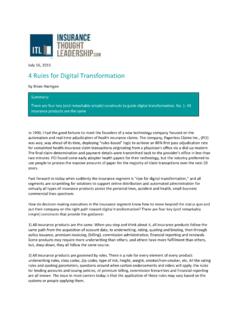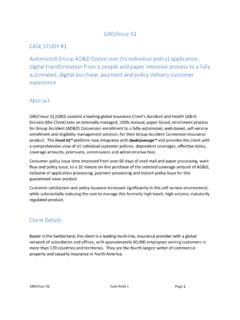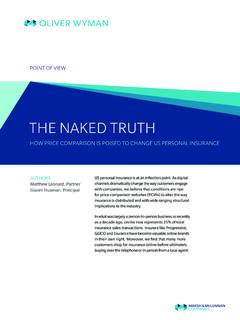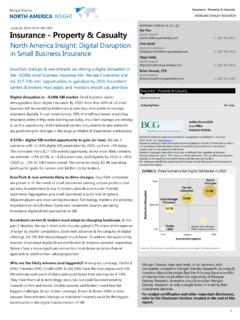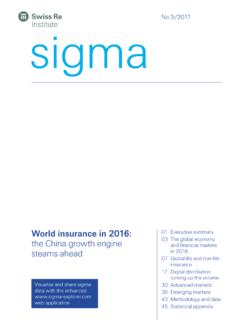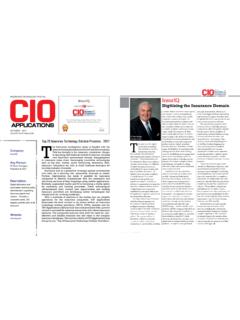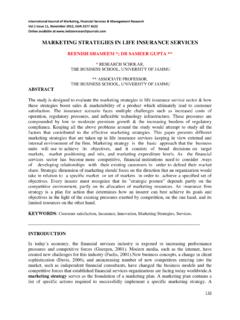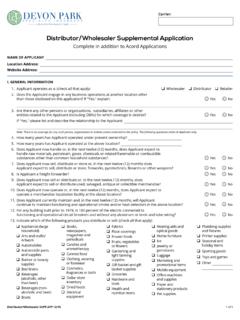Transcription of The future of distribution for insurers - EY
1 The future of distribution : insurers grapple with a rapidly changing landscapeInsurance Governance Leadership NetworkMay 2017 ViewPoints May 2017 TAPESTRY NETWORKS, INC +1 781 290 2270 The future of distribution : insurers grapple with a rapidly changing landscape Advancing technology and changing customer preferences, regulations, and market conditions are propelling significant shifts across the insurance distribution landscape. The need for insurance to be sold more directly and at a lower cost is not new; however, most insurance Governance Leadership Network (IGLN) participants agree that the mandate for change is greater today than in recent memory.
2 distribution will change. It must change. Business as usual is no longer working, one director Most IGLN participants view the mandate for change as the result of a system where, according to one, distribution is simply taking too much money out of premiums. Experts say the relative share of expenses related to distribution has been rising since the early 2000s, stubbornly resisting downward trends evident in other expense Participants quoted shares ranging from 15 to 40 cents of every dollar lost to distribution in the form of intermediary, acquisition, and technology fees and costs.
3 Maybe that is fine if you are adding a lot of value, suggested one director, but participants and, increasingly, customers, agree that the current structure does not provide enough value for the money. Although product type ( , retail or commercial, complex or simple) and local market conditions and customs drive variations in methods of distribution , participants in two IGLN meetings, in New York and London, and dozens of pre-meeting conversations observed a number of broad trends. See Appendix A for a list of participants. This ViewPoints synthesizes key insights emerging from these meetings and related discussions and centers on two themes.
4 Boards are increasingly focused on distribution strategy, impediments to transformation, and risks insurers foresee significant shifts in distribution systems in the near future Boards are increasingly focused on distribution strategy, impediments to transformation, and risks How can boards best balance their responsibilities to oversee and advise on distribution strategies without engaging in too many tactical elements that are often best left to management? Participants acknowledged that distribution is a consistent topic on the board agenda and that it needs to be managed like other strategic objectives via quarterly reviews, strong metrics, and challenges to management.
5 However, several participants noted that, given the nature of the topic, boards and management alike could focus too much on details. One director said this is a particular risk during times of major transition: When a company is going through a transformation, it requires the board to be much more engaged. Major decisions are made. You are dealing with huge investments in distribution will change. It must change. Business as usual is no longer working. Director insurance Governance Leadership Network The future of distribution : insurers grapple with a rapidly changing landscape 2 distribution networks, talent, etcetera, but you need a board that is strategic and long-term focused, not dealing with numbers and short-term issues.
6 Some participants pointed out that this is often easier said than done. In an effort to achieve optimal balance, participants discussed the following topics, highlighting areas where boards can focus attention and effort and add value as groups reimagine distribution . Evaluating changing distribution strategies and their timing and successful implementation can be difficult While understanding strategy and implementation are obvious and essential components of each director s role, several participants said understanding distribution systems in flux, the strategies to shift these systems, and how those strategies compare to the market can be difficult.
7 One director noted that decisions are not binary: It is not [a question of], D o you enter a market or leave? It is, How much do you invest in one solution and how much in another? How quickly should you migrate to digital and in what countries? There are a lot of moving parts. Another said, It can be challenging to understand how your strategy stacks up against others. Are we a leader or a follower? Another director said, Part of the solution is no longer selling insurance but selling solutions for people. How do we fit our business model with the potential hundreds of solutions out there?
8 See Appendix B for a list of distribution strategy questions for boards to consider. Ultimately, it is also true that the best distribution strategies can differ by product and geographic market, so diversified insurers may have several optimal strategies running concurrently in different market structures. One of the biggest challenges for boards may be sifting through the rhetoric to understand what going digital means for their groups. One participant charged, You have people saying implementing some new system means you are going digital. There is so much spin on this topic that you need to probe and go deeper.
9 This environment requires directors to have a heightened awareness and knowledge of advancing technology. One director said, It is my responsibility to move away from being ignorant. Most directors I know are actively engaged in continued learning to keep up-to -date. If they are not getting enough info, they should demand it. I ll never be an expert on these fancy things, but I better understand it because we will spend a lot of money on it. In addition to directors own efforts outside of the boardroom, an increasing number of boards are bringing in digital directors with specific skills and, in some cases, establishing technology committees to ensure efforts to digitize the enterprise receive appropriate attention.
10 Perhaps as important as the strategy itself is its timing and what should trigger a shift from relying on existing profitable businesses to new ventures. One director said, You don t want to be ahead of the game because you cannibalize your own business by going digital; you lose control of the customer relationship. But you don t want to be behind because others will eat your lunch. It is a tricky balance. One executive said, At what point do we stop milking the existing cow to move to the next one? It is about the economics and when do you jump. Another executive said, We always wanted a direct model, but if we have an intermediated model giving us a 20% margin, it is pretty hard to change.










